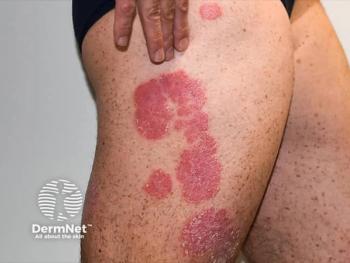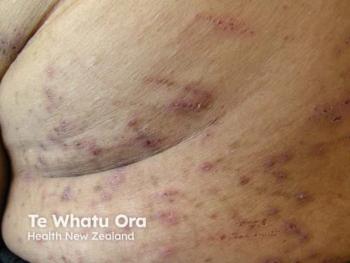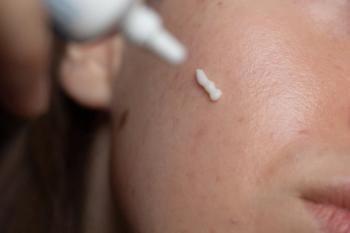
Phase 3 Trial Confirms Roflumilast’s Dual-Site Efficacy
Key Takeaways
- Roflumilast foam demonstrated significant efficacy in treating scalp and body plaque psoriasis, with rapid symptom relief and a favorable safety profile.
- The ARRECTOR trial showed that 66.4% of roflumilast users achieved scalp clearance or near-clearance, compared to 27.8% in the vehicle group.
Roflumilast foam shows significant efficacy in treating scalp and body psoriasis, enhancing patient adherence and quality of life in a recent clinical trial.
With nearly half of individuals with psoriasis reporting scalp involvement, treatment can be both physically and emotionally challenging. The presence of hair makes topical application difficult, often reducing adherence due to poor cosmetic acceptability and incompatibility with daily hair care routines. Foam formulations offer a modern alternative that may enhance treatment adherence and efficacy.1-2
ARRECTOR Study
A recent phase 3 clinical trial—
Results
In the ARRECTOR trial, 432 adolescent and adult participants were randomized in a 2:1 ratio to receive either roflumilast foam or vehicle foam once daily for 8 weeks. Eligibility required moderate scalp psoriasis and at least mild body psoriasis, with limited overall body surface area (BSA) involvement. Primary efficacy endpoints were based on improvements in the Scalp−Investigator Global Assessment (S-IGA) and Body−Investigator Global Assessment (B-IGA), while secondary endpoints included itch severity, patient-reported outcomes, and quality-of-life measures.
By week 8, significantly greater proportions of patients in the roflumilast group achieved S-IGA and B-IGA success compared to the vehicle group. Specifically, 66.4% of patients using roflumilast achieved scalp clearance or near-clearance (versus 27.8% in the vehicle group), and 45.5% saw similar success on the body (versus 20.1%). Improvements were evident early in the treatment period: “A significantly greater proportion of patients treated with roflumilast (50.1%) vs vehicle (16.8%) achieved PASI-75 at week 8.”
Itch—an often-debilitating symptom—was also significantly reduced. Success on the Scalp Itch−Numeric Rating Scale (SI-NRS) was achieved in 65.3% of the roflumilast group at week 8 versus 30.3% in the vehicle group. Notably, improvement began as early as 24 hours after initial application, with a measurable difference in itch severity between groups. The foam also demonstrated rapid improvement in the Worst Itch–Numeric Rating Scale (WI-NRS), reflecting overall symptom relief across scalp and body.
Filling Clinical Gaps
Roflumilast's formulation appears well-suited for hair-bearing areas, as it contains non-irritating excipients common in cosmetic products and lacks alcohol, fragrances, and other sensitizers. The authors highlight, “Roflumilast foam differs from other topical foam formulations because it contains excipients that maintain the skin barrier...and ensure its suitability for a wide variety of skin and hair types.”
Safety was consistent with prior studies. Treatment-emergent adverse events (TEAEs) occurred in 26.7% of the roflumilast group and 16.6% of the vehicle group, with most being mild or moderate. No new safety concerns were identified.
Conclusion
The authors found that roflumilast foam, 0.3%, demonstrated rapid, significant, and sustained improvement in both clinical and patient-reported outcomes in scalp and body plaque psoriasis, with a favorable safety profile. These findings suggest that roflumilast foam may offer an effective and well-tolerated treatment option, especially for those with scalp involvement where traditional topical therapies fall short. This study adds to the growing body of evidence that targeted, patient-friendly formulations can enhance both efficacy and quality of life for individuals living with chronic dermatologic conditions.
References
- Gooderham MJ, Alonso-Llamazares J, Bagel J, et al. Roflumilast foam, 0.3%, for psoriasis of the scalp and body: The ARRECTOR phase 3 randomized clinical trial. JAMA Dermatol. Published online May 07, 2025. doi:10.1001/jamadermatol.2025.1136
- Arcutis announces publication of positive data from ARRECTOR trial evaluating ZORYVE (roflumilast) foam 0.3% in individuals with psoriasis in Journal of American Medical Association Dermatology. News Release. Global Newswire. Published May 7, 2025. Accessed May 7, 2025.
https://www.globenewswire.com/news-release/2025/05/07/3076357/0/en/Arcutis-Announces-Publication-of-Positive-Data-from-ARRECTOR-Trial-Evaluating-ZORYVE-roflumilast-Foam-0-3-in-Individuals-with-Psoriasis-in-Journal-of-American-Medical-Association-D.html
Newsletter
Like what you’re reading? Subscribe to Dermatology Times for weekly updates on therapies, innovations, and real-world practice tips.


















